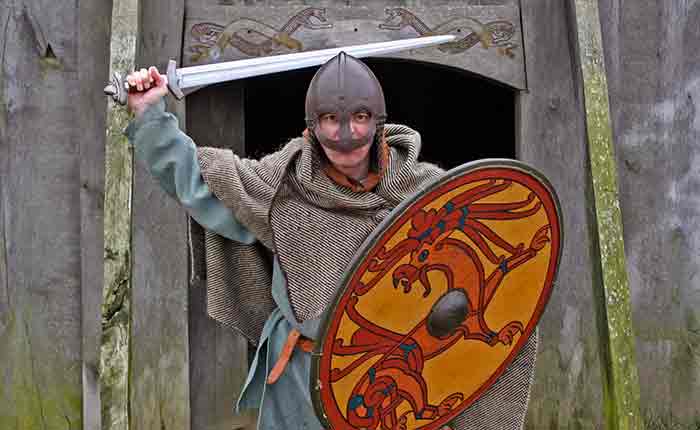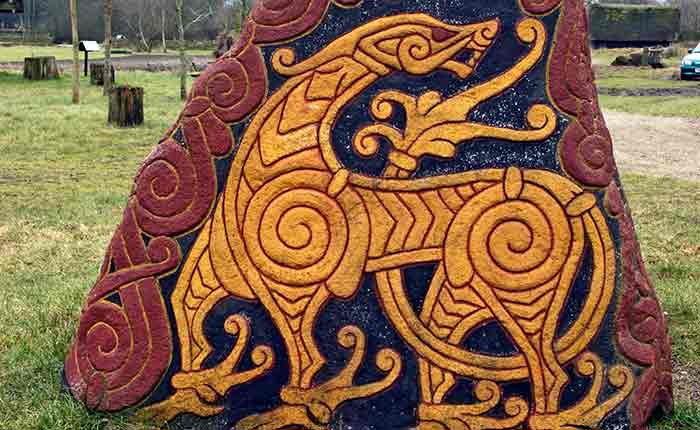They came from the sea. A whirlwind of violence.

In 793 AD, the Christian monastery of Lindesfarne off England’s Northumbrian coast was ransacked by pagans. They plundered and raped. They showed no mercy. These were the Vikings and they came to dominate Europe for the next 200 years.
Fearsome warriors though they were, it was technology that gave the Vikings the edge; in particular their longboats. Tough, flexible and manoeuvrable, these warships held as many as 100 men and were perfect for lightning raids on unsuspecting coastal villages. Ribe is Denmark’s oldest town, a delightful jumble of medieval streets and crooked wood-beamed houses. It’s perfect for a weekend break, and the nearby Viking Centre transports you back several millennia with surprising authenticity, correcting a few misconceptions about these ancient warriors along the way.

I expect to see scenes of barbarism when I arrive, but instead I find ancient domesticity.
Chickens straggle though the marketplace, women in dark smocks and hooded cloaks grind grain between mill stones, a potter throws clay on his wheel.
“People always talk about the plundering,” says Bjarne Clement the Centre’s Director. “But every society has its violent streak, its warriors. Most Vikings lived in villages and were tradespeople, part of a complex, organised society. The problem was that they were so successful, the land could no longer support their population so they had to seek other territories.”
Bjarne is dressed in rough woollen trousers, a hairy shirt and large cape fastened with a simple broach. He gives me my own Viking garb to wear. The clothes smell of woodsmoke and feel scratchy. But they fit well and are surprisingly snug; good insulation against the chilly breeze blowing across the flat Danish landscape.

Looking decidedly more barbarous, I walk back into the village. It’s like stepping into a time capsule. “The only things missing are the smells and the flies,” Bjarne says. “We used to chuck old bones and refuse outside the houses like the Vikings did, but the environmental health people insisted we dispose of them properly.”
[quote]The blacksmith was one of the most important men. One Viking king had his blacksmith’s legs chopped off so he couldn’t leave the village.[/quote]
From inside the first hut comes the roar of flames and the hush of bellows. Peter the blacksmith is preparing his fire. I’m put to work at the bellows. Pumping looks easy, but it isn’t. You have to pump the two bellows in tandem to deliver a constant stream of air into the glowing embers, otherwise you shower your blacksmith with sparks. Peter might not be a pillager, but he has a very big hammer. I don’t want to annoy him. He bangs a piece of white hot iron ringingly with his hammer, fashioning the beginnings of a spade. He was a teacher before he metamorphosed into a Viking. A self-taught blacksmith, he’s made every tool used here: knives, cooking pots, axes and arrows. “The blacksmith was one of the most important men in those days,” he grunts between bangs. “One Viking king had his blacksmith’s legs chopped off so he couldn’t leave the village.”

Nearby, Anders the carpenter is using a hoe-shaped axe to plane an oak beam. He brandishes the axe at me. Is he kicking into warrior mode? I wonder. No, he’s just asking me to try it. The axe looks like nothing we use today, but it’s an accurate copy of tools excavated nearby. “The axe was like a carpenter’s fingerprint,” explains Anders. “You can tell how many different people worked on a boat or house by their different axe strokes.” Future archaeologists will spot mine easily. They are distinctly ragged.
I retrieve some Anglo Saxon pride at the shooting range with a longbow. Englishmen might consider this one of our great inventions, but it was a weapon the Vikings used too. Several of the arrowheads Peter has fashioned can penetrate metal with ease.
[quote]My time-trip ends in the longhouse. [/quote]
Marlene and Stefanie are stirring a black pot of porridge over a crackling fire. Before porridge I’m handed an egg. The shell is cracked. Peeling it reveals mottled brown egg-white. A squirt of brown goo comes out of it. “It was boiled with onions and salt to preserve it,” explains Bjarne helpfully. I close my eyes and take a bite, trying not to gag. I was expecting a mouthful of sulphur, but it’s just a little salty. Washed down with some Viking mead it tastes pretty good.
The Viking Centre’s authenticity derives from its close ties with the Viking Museum in Ribe. Excavations of the Viking settlement here have yielded all sorts of insights. There’s a fascinating array of broken pots, jewellery and weapons. You can also try some slightly more palatable Viking vitals. They serve a tasty Viking lunch which includes smoked venison and wild berries. Just don’t expect to be given a fork. They hadn’t been invented.

[quote]I wanted to learn more about the longship, key to the Vikings’ success at conquest and colonisation. [/quote]
Roskilde, a couple of hours’ east, is home to Denmark’s Viking Ship Museum. Here, in 1956 five Viking ships were found in the entrance to a fjord. It took a team of archaeologists 25 years to exhume them from their watery tombs. The millennia year-old wood is impregnated with a special polymer to stop it disintegrating. Having pieced together Denmark’s largest jigsaw, they decided to build boats themselves using traditional tools and techniques. The result is a veritable flotilla. In summer you can try rowing and sailing them. If you’ve got £50,000 to spare, you can even buy one, though you’ll have to wait six months whilst they build it.
I met Louise another modern Viking here. The museum’s pièce de résistance is a sea-worthy replica of a warrior longboat. It cost £1 million and took five years to build. Louise and 70 others rowed and sailed this ancient war machine round the north coast of Scotland to Dublin in 2007. Although the boat can reach speeds of 15 knots under sail, it took weeks. “You have to be a certain kind of person to crew a longboat,” she says. “There’s no personal space and no protection from the elements. You sleep on deck and the toilet’s a bucket in the bows.”
Historians say this era of Scandinavian supremacy finished in 1066 at the Battle of Hastings. King Harold was of Viking descent and his vanquishing by William the Conqueror was the first time the Vikings had been beaten in battle. The Bayeux Tapestry records this defeat in detail. My Viking journey ended in the Danish capital, Copenhagen. An exhibition at the National Museum here features a half-size reproduction of the tapestry. The accuracy of the depictions of armour, boats, clothing and animals provides some of the best clues for modern day Vikings about their rampaging ancestors. There, intricately embroidered, are fleets of those longboats, their occupants armed to the teeth. I wonder what happened to that side of the Danish psyche? I was expecting berserkers and blood lust, but modern day Vikings are typically Scandinavian. Relaxed and easy going. “Vikings these days are portrayed either as pillagers or as amiable tubby drunkards with horned helmets,” explained Jesper my guide.
“As Danish society looked for its post-war identity, the Viking turned from a rampaging warrior into a friendly guy who’s more interested in necking pints than raping and pillaging.”
You won’t find modern day Vikings tearing up the town. For the rest of us, maybe that’s not such a bad thing.
[hr]
Fancy being a Viking?
Get There: Fly to Copenhagen with easyJet or Norwegian . Then drive to Ribe.
Stay There: The 3 star Dagmar Hotel in Ribe is full of character and great value too.
Find Out More: Here’s a bunch of useful websites